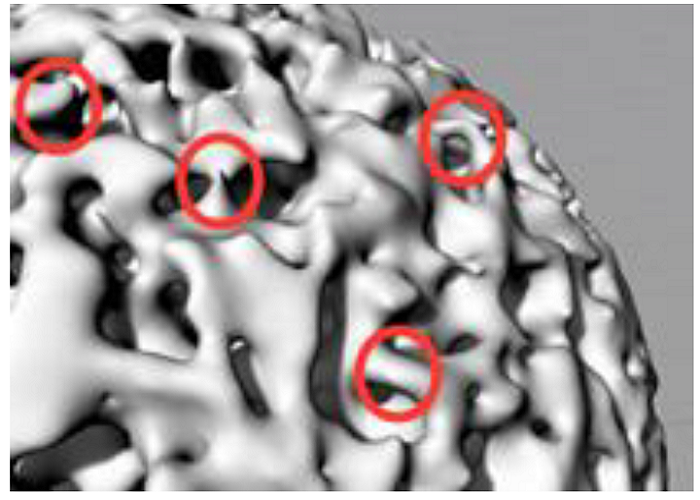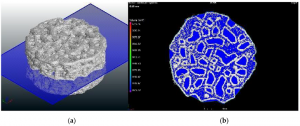From manufacturing customized prosthetics and implants to surgical planning and bioprinting organs and tissues, 3D printing has many medical applications. In terms of bone tissue engineering and 3D bioprinting, 3D printed scaffolds are used as templates to help with tissue formation and initial cell attachment, as well as to fix prostheses through osseointegration. We’ve seen scaffolds made with all sorts of materials, like a compound in turmeric, sugar, and plastic, but the best are those with good porosity that can simulate tissue.
It’s not always easy to fabricate porous structures with specific pore sizes using FDM technology. A trio of researchers from the Polytechnic University of Catalonia (UPC) in Barcelona published a paper, titled “3D Printing of Porous Scaffolds with Controlled Porosity and Pore Size Values,” explaining how they developed a new method of designing porous scaffolds for FDM 3D printing.
The abstract reads, “The present paper provides a methodology to design porous structures to be printed. First, a model is defined with some theoretical parallel planes, which are bounded within a geometrical figure, for example a disk. Each plane has randomly distributed points on it. Then, the points are joined with lines. Finally, the lines are given a certain volume and the structure is obtained. The porosity of the structure depends on three geometrical variables: the distance between parallel layers, the number of columns on each layer and the radius of the columns. In order to obtain mathematical models to relate the variables with three responses, the porosity, the mean of pore diameter and the variance of pore diameter of the structures, design of experiments with three-level factorial analysis was used. Finally, multiobjective optimization was carried out by means of the desirability function method. In order to favour fixation of the structures by osseointegration, porosity range between 0.5 and 0.75, mean of pore size between 0.1 and 0.3 mm, and variance of pore size between 0.000 and 0.010 mm2 were selected. Results showed that the optimal solution consists of a structure with a height between layers of 0.72 mm, 3.65 points per mm2 and a radius of 0.15 mm. It was observed that, given fixed height and radius values, the three responses decrease with the number of points per surface unit. The increase of the radius of the columns implies the decrease of the porosity and of the mean of pore size. The decrease of the height between layers leads to a sharper decrease of both the porosity and the mean of pore size. In order to compare calculated and experimental values, scaffolds were printed in polylactic acid (PLA) with FDM technology. Porosity and pore size were measured with X-ray tomography. Average value of measured porosity was 0.594, while calculated porosity was 0.537. Average value of measured mean of pore size was 0.372 mm, while calculated value was 0.434 mm. Average value of variance of pore size was 0.048 mm2, higher than the calculated one of 0.008 mm2. In addition, both round and elongated pores were observed in the printed structures. The current methodology allows designing structures with different requirements for porosity and pore size. In addition, it can be applied to other responses. It will be very useful in medical applications such as the simulation of body tissues or the manufacture of prostheses.”
In order to design 3D printed porous scaffolds that can simulate tissues, they need mechanical strength, which helps with protection and support; permeability, which can direct the transport of nutrients; and surface area and interconnectivity, both of which relate to good cell growth. Other researchers have tried to achieve the necessary porosity in scaffolds by using hierarchical design and topology optimization. But the UPC team went a different way.
“Unlike other methods that are based on truss structures, the present model allows obtaining irregular porous structures from random location of columns in the space, which leave voids among them. Specifically, the structure was modelled with parallel planes joined by columns, with a certain number of columns on each plane,” the researchers wrote.
They applied their model to a disc shape and defined three different variables:
- Distance between parallel planes
- Number of base points for columns on each plane
- Radius of each column
Then, the team used dimensional analysis to lower the number of process variables to just two, and so defined their requirements “for a specific application case: the use of a porous structure in external layers of hemispherical hip prostheses.”
To compare the results of their experiment with computationally calculated results, the researchers used a dual-extruder Sigma 3D printer from BCN3D to fabricate three sample scaffolds out of PLA, then measured their pore size and total porosity. The researchers found that the measured results were not dissimilar to the calculated results.
“In future work, other requirements for structures, related to either mechanical strength or mass transport, will be addressed. In addition, improvement of the FDM printing process is required in order to obtain more accurate and smooth parts,” the researchers concluded.
Co-authors of the paper are Irene Buj-Corral, Ali Bagheri, and Oriol Petit-Rojo.
Discuss this research and other 3D printing topics at 3DPrintBoard.com or share your thoughts below.
Subscribe to Our Email Newsletter
Stay up-to-date on all the latest news from the 3D printing industry and receive information and offers from third party vendors.
You May Also Like
The Third World War & The Disruption of US Military Power
A Reddit user once remarked, “The most terrifying capability of the United States military remains the capacity to deploy a fully operational Burger King to any terrestrial theater of operations...
Australia to Go Orbital: Gilmour Space Gears up for Historic Launch
Australia is on the brink of a historic achievement in space exploration. Gilmour Space Technologies, a pioneering company based on the Gold Coast, has secured the nation’s first-ever orbital launch...
3D Printing Webinar and Event Roundup: November 10, 2024
We’ve got another busy week ahead of webinars and events around the world! There are multiple open houses and conferences, advanced AM training, a 3D printer launch event, our own...
3D Printing News Briefs, November 9, 2024: Concept Car, Afloat 3D Printing, & More
In today’s 3D Printing News Briefs, we’ll start with business, as Anisoprint appointed AM industry veteran Tuan TranPham as President of the Americas and APAC. Then we’ll move onto automotive...







































